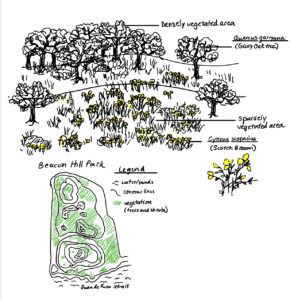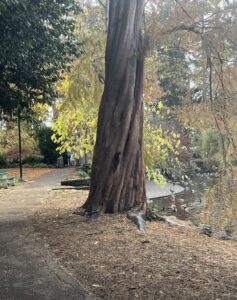Date and time: 27/09/2024, 13:00-14:00
Season: Early Fall
Weather: 16°C and mostly sunny, 75% humidity, minimal wind
Location: Beacon Hill park, Victoria, BC
Designation: City park
Coordinates: 48.41501° N, 123.36508° W
The area I’ve chosen is Beacon Hill Park: a city park in Victoria, BC, located along the Juan De Fuca Strait spanning 183 acres. Due to its size, I focused on the Northern end of the park closest to the shore. I visited from 13:00-14:00. It was 16°C and mostly sunny, with 75% humidity and minimal wind.
Topography: There are open rolling hills and flat regions, with the largest slope being Beacon hill located at the northern end of the park. There are walking paths throughout the park with the close surrounding areas being clearly more maintained with few weeds. There are forested areas with dense vegetation, open landscaped grassy areas, as well as several presumably man-made ponds throughout flat regions of the park.
Vegetation: The park has a variety of native and exotic vegetation, ornamental shrubs, and flower beds. The pond vegetation is classic for a wetland ecosystem with algae, aquatic weeds, and lily pads. I noticed native trees such as Douglas-fir (Pseudotsuga menziesii), Grand fir (Abies grandis), Western Red-cedar (Thuja plicata) and Garry Oak (Quercus garryana). The northern part is more sparsely vegetated in comparison to other areas, with mostly weeds, grass, and Quercus garryana. I identified the invasive perennial shrub Scotch Broom (Cytisus scoparius).
Ecological gradients of interest: There was a transition from a belt of dense grassy woodland consisting of mainly Pseudotsuga menziesii and Abies grandis trees to an open, dry grassland area with hills and few trees closer to the shore. There were two distributions of Quercus garryana: areas of open grass and dense shrub layer (primarily Cytisus scoparius) with sparse oaks and areas of dense oak woodland with an understory of shrubs and other plants, but less Cytisus scoparius. There appeared to be more Cytisus scoparius in the open hilly grassland areas than in wooded areas.
Questions: What is causing the differences in distribution and abundance of Quercus garryana? Are these differences naturally occurring or affected by human activity?
Why do the open hilly grassland areas appear to be more susceptible to invasion by Cytisus scoparius than densely wooded areas?
Why are Pseudotsuga menziesii and Abies grandis trees mainly found on lower ground in the Southeast area of the park, slightly further from the shore?

